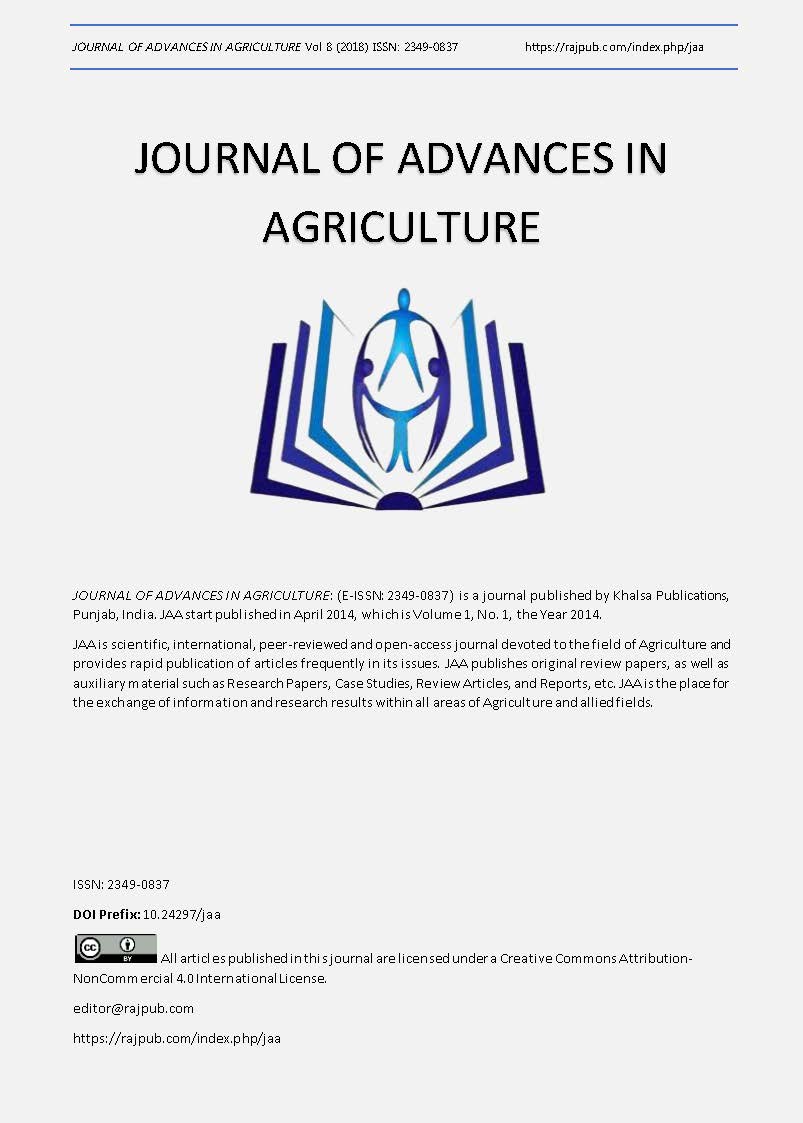Interaction Between Oryctes Rhinoceros and Leaves’ Nutrient Content in Oil Palm
DOI:
https://doi.org/10.24297/jaa.v8i1.7585Keywords:
Oil Palm, Oryctes rhinoceros, nutrient content, Phosphorus (P), Potassium (K)Abstract
A study meant to evaluate the relationship between the presence of Oryctes rhinoceros to the oil palm in relation to the leaves’ nutrient content which is Phosphorus (P) and Potassium (K). Appropriate fertilization is one of the methods that can help to suppress the pests’ presence in the field. In general, insects’ pests are attracted to the plants that are supplied with excess supply of nutrient as it can help them to develop better in future as these nutrient play their roles in aiding through growths and insects’ fecundity. Data on nutrient status were collected were Phosphorus (P), Potassium (K), Calcium (Ca), Magnesium (Mg), Copper (Cu) and Zinc (Zn). These data had been collected twice per month which were at the middle and at the end of each month. Four samples of leaves were taken from four sampling oil palm trees of each treatment. Leaves from ninth or seventeenth fronds were chosen as it is the best most ideal fronds to be used for leaf analysis to identify the nutrient content. The result of this study showed that Phosphorus (P) exerted a strong positive relationship with the presence of Oryctes rhinoceros in the oil palm while Potassium (K) showed a strong negative relationship between the two variables. Thus, developing awareness to the growers to this nutrients-balancing issue would be good for future agriculture in future as it is clear now that balanced nutrition is primordial to ensure availability of nutrients uptake by plants.
Downloads
References
Abbas, G., Hussain, A., Ahmad, A. and Wajid, S.A. (2005). Effect of irrigation schedules and nitrogen rates on yield and yield components of maize. Journal of Agriculture & Social Science, 1, 335-338.
Altieri, M. A., & Nicholls, C. I. (2003). Soil fertility management and insect pests: harmonizing soil and plant health in agroecosystems. Soil and Tillage Research,72(2), 203-211.
Amtmann, A., Troufflard, S., and Armengaud, P. (2008). The effect of potassium nutrition on pest and disease resistance in plants. Physiologia Plantarum, 133(4), 682-691.
Bakht, J., Siddique, M.F., Shafi, M., Akbar, H., Tariq, M., Khan, N., Zubair, M. and Yousef, M. (2002). Effect of planting method and nitrogen levels on the yield and yield components of maize. Sarhad Jounral of Agriculture, 23, 553-559.
Fairhurst, T.H., and E. Mutert. (1999). Interpretation and management of oil palm leaf analysis data. Better Crops International.13(1):48-51.
Flechtmann, C.H.W. and Malavolta, E. (1976). Studies on the mineral nutrition of grain sorghum. III. Populations of the common two spotted spider mite on grain sorghum grown on various levels of N, P and K. Communications in Soil Science and Plant Analysis, 7 (9), 839-841.
Huber, D., Romheld, V. and Weinmann, M. (2012). Relationship between nutrition, plant disease and pests. Marschner’s Mineral Nutrition of Higher Plants, 283-298.
Johnston, A.E. and Milford, G.F.J. (2012). Potassium and nitrogen interaction in crops. Retrieved from https://www.pda.org.uk/technical potash-notes/potassium-and-nitrogen-interactions-in-crops/.
Kalra, Y.P. (2000). Handbook of reference methods for plant analysis. CRC Press, NW Corporate BVLO, Boca Raton, Florida.
Khan, F., Fahad, S., Faisal, S. and Hussain, S. (2014). Effect of different levels of nitrogen and phosphorus on the phenology and yield of maize varieties. American Journal of Plant Science, 5, 2582-2590.
Kulagod, S.D., M.G. Hedge., G.V. Nayak., A.S. Vastrad, and P.S. Hugar. (2011). Influence of fertilizer on the incidence of insect pests in paddy. Karnataka J. Agric. Sci. 24(2): 241-243.
Krishnamoorthy, V. and Madagaleri, M.B. (2000). Effect of interaction of nitrogen and phosphorus on seed and essential oil yield of ajowan (Trachyspermum ammi.L) genotype. Journal of Spices and Aromatic. 9(2), 137-139.
Mohd Rasdi, Z., Che Salmah, M.R. and Abu Hassan, A.(2013). Effect of nutrient and pre - infested brinjal, Solanum melongena by whitefly and aphid on population dynamics of whitefly, Bemisia tabaci. Agriculture, Forestry and Fisheries, 2(1), 1-10.
Morales, H., Perfecto, I. and Ferguson, B. (2001). Traditional soil fertilization and its impact on insect pest populations in corn. Agric.Ecosyst.Environ.84,145-155.
Moschler, W.W. and Martens, D.C. (1975). Nitrogen, phosphorus and potassium requirements in no-tillage and conventionally tilled corn. Soil Science Society of America, Proceedings, 39, 886-891.
Nevo, E. and Coll, M. (2011). Effect of nitrogen fertilization on Aphis gossypii (Homoptera:Aphididae): variation in size,colour,and reproduction. J. Econ.Entomol.,94,27-32.
Parthasarathy, S. (2015). Effect of fertilizers on plant diseases. Retrieved from http://agropedia.iitk.ac.in/content/effect-fertilizers-plant-diseases
Ranade-Malvi, U. (2011). Interaction of micronutrients with major nutreints with special reference to potassium. Karnataka. J.Agric.Sci., 24(1), 106-109.
Rashid, M. M., Jahan, M., & Islam, K. S. (2016). Impact of Nitrogen, Phosphorus and Potassium on Brown Planthopper and Tolerance of Its Host Rice Plants. Rice Science,23(3), 119-131.
Sarwar, M,. (2012). Effects of potassium fertilization on population build up of rice stem borers (lepidopteran pests) and rice (Oryza sativa L.) yiled. J Cereals Oilseeds,3,6-9.
Shivaji, R., Camas, A., Ankala, A., Engelberth, J., Tumlinson, J.H., Williams, W.P., Wilkinson, J.R. and Luthe, D.S. (2010). Plants on constant alert: elevated levels of jasmonic acid and jasmonate-induced transcripts in caterpillar-resistant maize. J.Chem.Ecol., 36, 179- 191.
Singh B, Singh Y, Imas P, Chang X.J. (2003). Potassium nutrition of the rice- wheat cropping system. Advances in agronomy, Academic press, 81,203-259.
Spann, T.M. and Schumann, A.W. (2013). Mineral nutrition contributes to plant disease and pest resistance. University of Florida, 1-4.
Walling, L.L. (2000). The myriad plant responses to herbivores. Department of Botany and Plant Science, University of California, Riverside, California 92521-0124.JPGR.Journal of Plant Growth Regulation,19,195-304.
Wang, M., Zheng, Q., Shen, Q. and Guo, S. (2013). The Critical Role of Potassium in Plant Stress Response. International Journal of Molecular Sciences. 14(4), 7370-7290.
Published
How to Cite
Issue
Section
License
 All articles published in Journal of Advances in Linguistics are licensed under a Creative Commons Attribution 4.0 International License.
All articles published in Journal of Advances in Linguistics are licensed under a Creative Commons Attribution 4.0 International License.




